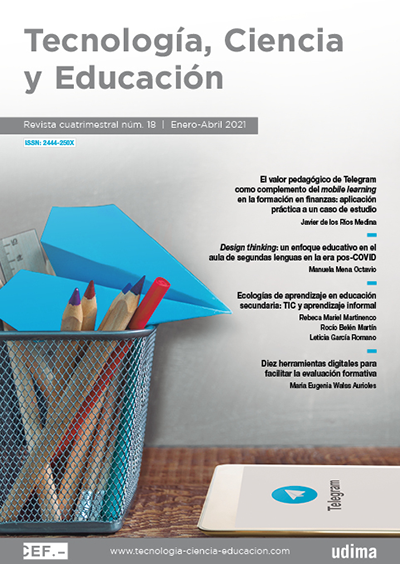Design thinking: an educational approach in the second language classroom in the post-COVID era
DOI:
https://doi.org/10.51302/tce.2021.569Keywords:
design thinking (DT), empathy, digital competence, online teaching, e-learning, second language learning, COVIDAbstract
The new scenario that is opening up in the classrooms of our country with the arrival of the post-COVID era could be the definitive lever for change to modify the archaic structures on which our current educational system is based. In this new context there are two elements that will play a crucial role: empathy and technology.
This research work aims to justify the need to implement an approach like design thinking (DT) within the remote teaching-learning model. It also presents an innovative educational experience for the online foreign language classroom with high school students with the purpose of promoting empathy, digital competence and collaborative learning by carrying out meaningful online tasks.
Downloads
References
Area, M. y Adell, J. (2009). E-learning: enseñar y aprender en espacios virtuales, 1-30. https://www.researchgate.net/publication/216393113_ELearning_ensenar_y_aprender_en_espacios_virtuales
Arnheim, R. (1969). Visual Thinking. University of California Press.
Attwell, G. (2007). The personal learning environments-the future of e-learning? eLearning Papers, 2(1), 1-9.
Autor, D. H. y Price, B. (2003). The Changing Task Composition of the US Labor Market: An Update of Autor, Levy, and Murnane, 1-19. https://economics.mit.edu/files/9758
Bloom, B. S. (Ed.). (1956). Taxonomy of Educational Objectives: The Classification of Educational Goals. David McKay Company.
Brown, T. (2009). Change by Design: How Design Thinking Transforms Organizations and Inspires Innovation. Harper Collings Publishers.
CEOE. (2016). Plan digital 2020: la digitalización de la sociedad española. http://contenidos.ceoe.es/CEOE/var/pool/pdf/publications_docs-file-334-plan-digital-2020-la-digitalizacion-de-la-sociedad-espanola.pdf
Docplayer. (2017). Informe sobre el progreso digital en Europa (EDPR) 2017: perfil de España. https://docplayer.es/66723595-Informe-sobre-el-progreso-digital-en-europa-edpr-2017-perfil-de-espana.html
Grundmann, U. y Arnheim. R. (2001). The intelligence of vision: an interview with Rudolf Arnheim. Cabinet Magazine, 2. http://cabinetmagazine.org/issues/2/grundmann_arnheim.php
Interempresas. (2019). El informe Eurydice: análisis de la educación digital en el curso académico 2018/2019 en los 38 países del programa Erasmus+. https://www.interempresas.net/Tecnologia-aulas/Articulos/256122-Informe-Eurydice-analisis-educacion-digital-curso-academico-2018-2019-38-paises-programa.html
Lee, D. (2018). Design Thinking in the Classroom: Easy-to-Use Teaching Tools to Foster Creativity, Encourage Innovation and Unleash Potential in Every Student. Ulysses Press.
Ministerio de Educación y Formación Profesional. Las competencias clave en el sistema educativo español según la Orden ECD/65/2015, de 21 de enero, relaciones entre las competencias, los contenidos y evaluación de primaria, ESO y bachillerato. https://www.educacionyfp.gob.es/educacion/mc/lomce/curriculo/competencias-clave/competencias-clave.html
Morin, E. (1999). Los siete saberes necesarios para la educación del futuro. Paidós Estudio.
Robinson, K. y Aronica, L. (2015). Escuelas creativas: la revolución que está transformando la educación. Editorial Grijalbo.
Rubio, A. (2014). La educación a distancia en España. http://www.lmi.ub.es/teeode/THEBOOK/files/spanish/html/6spain.htm
Spencer, J. y Juliani, A. J. (2016). Usign Design Thinking to Boost Creativity and Bring Out the Maker in Every Student. Dave Burgess Consulting, Inc.
Trujillo, F. (2020). El potencial de la educación virtual. El País. https://elpais.com/especiales/2020/coronavirus-covid-19/predicciones/el-potencial-de-la-educacion-virtual/
Szczepanska, J. (2017). Design Thinking Origin Story Plus Some of the People Who Made It All Happen. https://medium.com/@szczpanks/design-thinking-where-it-came-from-and-the-type-of-people-who-made-it-all-happen-dc3a05411e53
Downloads
Published
How to Cite
Issue
Section
License
Copyright (c) 2021 Manuela Mena Octavio

This work is licensed under a Creative Commons Attribution-NonCommercial-NoDerivatives 4.0 International License.

























